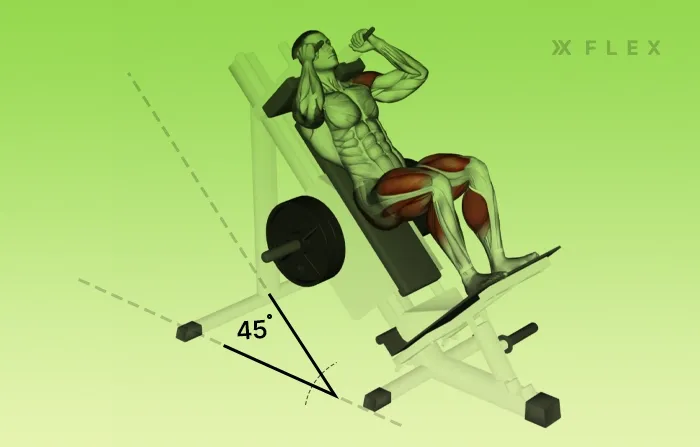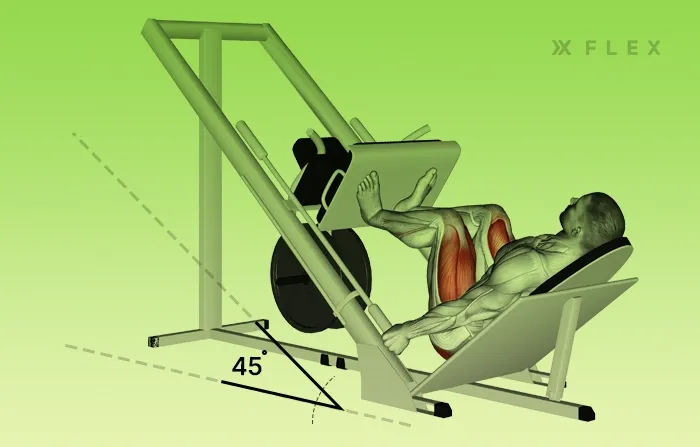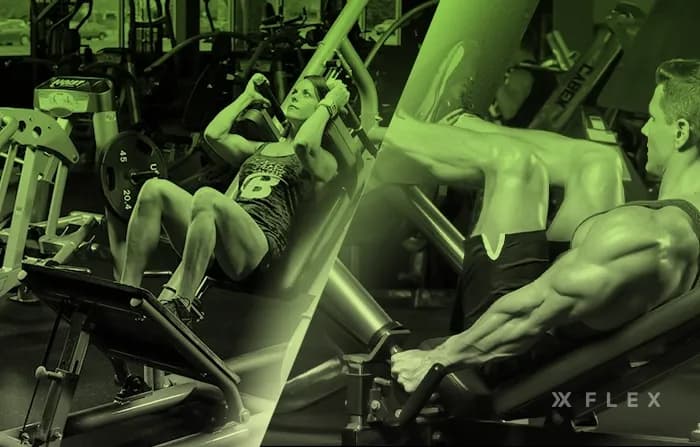Hack Squat vs. Leg Press: Pros, Cons & Muscles Worked
Explore the differences between the hack squat and leg press exercises, and discover which one is best suited for your fitness goals.
We’re not skipping leg day anymore. If you don’t want to be the person who’s built up top, yet scrawny down below, listen up. Let’s get familiar with the hack squat vs. leg press.
You can incorporate these two powerful leg muscle builders into your leg day routine for strength, endurance, and muscular hypertrophy. Whether you're a novice or an experienced lifter, the hack squat and leg press should be part of your arsenal.
Although some less experienced lifters may assume that these moves are interchangeable, there are a few key differences to note.
Depending on your fitness level and goals, there may be one that is better suited for your exercise plan.
On top of this, physical constraints like back pain or mobility issues may play a role in determining which exercise is more conducive to hitting your fitness targets.
This article will give you the low down on some of the key similarities and differences between the two exercises.
Understand how to perfect each move. And learn whether one or the other is preferable to suit your training goals.
How Does the Hack Squat Work?

Think of a hack squat as a machine-assisted version of the traditional barbell back squat.
Like a regular squat, hack squats load weight across your back to provide resistance to your movement.
The major difference between a traditional barbell squat and a hack squat is the addition of a machine rather than a free barbell. Even if you use a spotter for your barbell back squats, adding a machine offers even more support.
Because you load the shoulders with a hack machine, hack squats can provide added stability for people who feel shaky in a regular barbell squat.
During a barbell back squat, you have many small core and leg stabilizer muscles that go to work to keep you upright in your squat while you balance a heavy weight across your upper back.
Because of the way a barbell is designed, if you don’t use the perfect technique in a traditional squat, your barbell can easily throw you off balance.
What is the difference in the hack squat vs. squat? The hack squat provides increased stability compared to a regular cage squat using a loaded barbell.
Locking yourself into a machine adds to the stability of your body. So if you feel a little uneasy lifting such a heavy weight with no side support, give the hack squat a try. Because it’s more stable than a barbell squat for most people, you may also be able to up your weight more easily if you’re going for heavy resistance on your leg muscles.
Fun fact: a hack squat isn't just done on hack squat machines. This versatile lower body workout can be done with several pieces of equipment. Voilà!
What Muscles Does the Hack Squat Work?
Glutes
The gluteal muscles help you extend your hips. They connect the upper and lower body and help with everyday functional movements like walking or squatting down to pick things up.
Hamstrings
Hamstrings are the muscles at the backs of your thighs. These leg muscles help you extend your legs and bend your knees.
Quads
The quadriceps femoris (quads) help you extend your legs at the knees and flex your hips.
Calves
Calves help you with plantar flexion of your feet (pointing your toes). People also love to skip training calves.
Back Muscles
The lower back muscles like your Erector spinae help you flex your spine to maintain your posture.
Although we don’t think of squatting or leg pressing as being a big back exercise (in a leg training context, that’s more associated with the deadlift), your back certainly does go to work here, if only to help keep your body stable and upright.
Peter Miljak demonstrates proper technique to get deep knee flexion for a solid quad workout with the hack squat machine.
How Does the Leg Press Work?

Like the hack squat, the leg press is a lower–body-focused machine that helps you train and grow your leg muscles.
Most leg press machines in commercial gyms are loaded with weight stacks. After you add weight, the leg press requires you to push your feet against the footplate to drive your loaded weight up into a lift.
Depending on which muscles you hope to target, you can choose different foot placements on your leg press.
Standard placement in the middle of the press will target your leg muscles evenly. High foot placement on the footplate helps target the glutes. Low foot placement works your hamstrings and glutes more and brings an emphasis to the hip flexors for a better range of motion.
Most of us have tight hip flexor muscles and often neglect to keep them mobile. But good hip mobility helps alleviate pain in your back and can improve your athletic performance.
What Muscles Does the Leg Press Work?
Although the leg press also works your quads, it’s not as efficient as the hack squat at hitting your glutes or hamstrings.
The leg press doesn’t require as much core stabilization through the abdominal muscles as the hack squat would since you are in a supported seated position, rather than squatting on a platform.
Key Differences Between the Leg Press and the Hack Squat
As you can see, there are a few main differences between hack squats and leg presses, although they work similar muscles.
- Hack squats work more muscles. Because it mimics a traditional barbell squat only using a machine, the hack squat is more comprehensive than the leg press.
- Leg presses isolate your quads.
- The hack squat is a bit harder. This is a generalization, but most lifters find hack squats to be more challenging than a leg press, although less difficult than a full barbell back squat.
Who Should Do Leg Press vs. Hack Squat?
Although both these moves are great at helping you build a sculpted lower body, (maybe even a heart-shaped or rounded butt, who knows. Dream big, right?) there may be some external factors you’ll want to consider while choosing which one should be a mainstay in your leg day toolkit.
Back Pain
If your back is a sore spot for you, the leg press is your friend. Hack squatting puts more strain on your lower back in comparison with the leg press machine. Since you need to brace your body more in this movement, your low back muscles like the Erector spinae play a role in keeping you stable.
Core Focus
Want to throw in an ab workout while you train your legs? Go for the hack squat!
Because it needs more stabilization, you work your abdominals more here. The muscles of the lower back like the Erector spinae also work in conjunction with your abdominal muscles to help you maintain a strong core.
Balance
If your balance is no bueno, go for the leg press. As we mentioned the hack squat, although assisted more than a barbell squat, does require better stability than the leg press.
For more support, sitting comfortably on your leg press will put you at ease and have your leg lifting heavy loads in a way that feels smooth and secure.
Big Picture
Although these leg-strengthening exercises are similar, hack squats and leg presses are not the same.
Hack squats more closely mimic traditional squats, while the leg press is more isolated.
This means a hack squat requires more core activation and leg stabilization than a leg press would.
The leg press is also a more quad-centric move. Although you can alter your leg placement on the footplate of your leg press to change the muscle isolation to some degree, this movement is generally less of a total-body exercise than a hack squat would be.
Regardless, these are both phenomenal ways to boost your leg muscle mass. Make sure to always maintain proper rest methods like focusing on muscle recovery outside the gym.
You also need good nutrition to build muscle. If you struggle to pack on mass and find your physique is too lean and you can’t bulk up, take some time to consider your nutrition.
A proper diet, or even supplements like creatine may be good muscle-building enhancers to look further into.
Remember to consult a doctor or sports nutritionist before making significant changes to your diet to ensure you’re hitting your daily caloric requirements.
If you want more motivation to keep your nutrition in check and never skip another leg day, Flex offers an all-in-one workout platform to help do just that.
You can learn new exercises, visualize your fitness journey and keep all your PRs in one place, with tracking integrations to hit your daily caloric intake for growth, maintenance or weight loss.
Get simple customized fitness plans or introduce a little friendly competition to your fitness community by sharing exercises with your friends. Try it for free through the Flex fitness app.
References
Binstead JT, Munjal A, Varacallo M. Anatomy, Bony Pelvis and Lower Limb: Calf. [Updated 2023 May 23]. In: StatPearls [Internet]. Treasure Island (FL): StatPearls Publishing; 2023 Jan-. Available from: https://www.ncbi.nlm.nih.gov/books/NBK459362/
Bordoni B, Varacallo M. Anatomy, Bony Pelvis and Lower Limb: Thigh Quadriceps Muscle. [Updated 2023 May 8]. In: StatPearls [Internet]. Treasure Island (FL): StatPearls Publishing; 2023 Jan-. Available from: https://www.ncbi.nlm.nih.gov/books/NBK513334/
Elzanie A, Borger J. Anatomy, Bony Pelvis and Lower Limb, Gluteus Maximus Muscle. [Updated 2023 Apr 1]. In: StatPearls [Internet]. Treasure Island (FL): StatPearls Publishing; 2023 Jan-. Available from: https://www.ncbi.nlm.nih.gov/books/NBK538193/
Gordon, R., & Bloxham, S. (2016). A Systematic Review of the Effects of Exercise and Physical Activity on Non-Specific Chronic Low Back Pain. Healthcare (Basel, Switzerland), 4(2), 22. https://doi.org/10.3390/healthcare4020022
Henson B, Kadiyala B, Edens MA. Anatomy, Back, Muscles. [Updated 2023 Aug 14]. In: StatPearls [Internet]. Treasure Island (FL): StatPearls Publishing; 2023 Jan-. Available from: https://www.ncbi.nlm.nih.gov/books/NBK537074/
Krzysztofik, M., Wilk, M., Wojdała, G., & Gołaś, A. (2019). Maximizing Muscle Hypertrophy: A Systematic Review of Advanced Resistance Training Techniques and Methods. International journal of environmental research and public health, 16(24), 4897. https://doi.org/10.3390/ijerph16244897
Rodgers CD, Raja A. Anatomy, Bony Pelvis and Lower Limb, Hamstring Muscle. [Updated 2023 Apr 1]. In: StatPearls [Internet]. Treasure Island (FL): StatPearls Publishing; 2023 Jan-. Available from: https://www.ncbi.nlm.nih.gov/books/NBK546688/
Related articles


Get fit with Flex
Build muscle & lose weight fast for free.
Available on iPhone + Apple Watch





